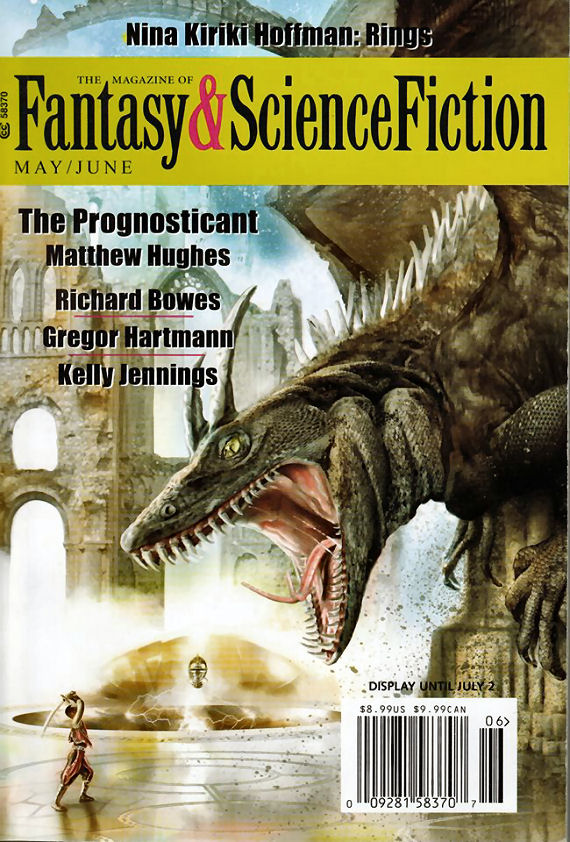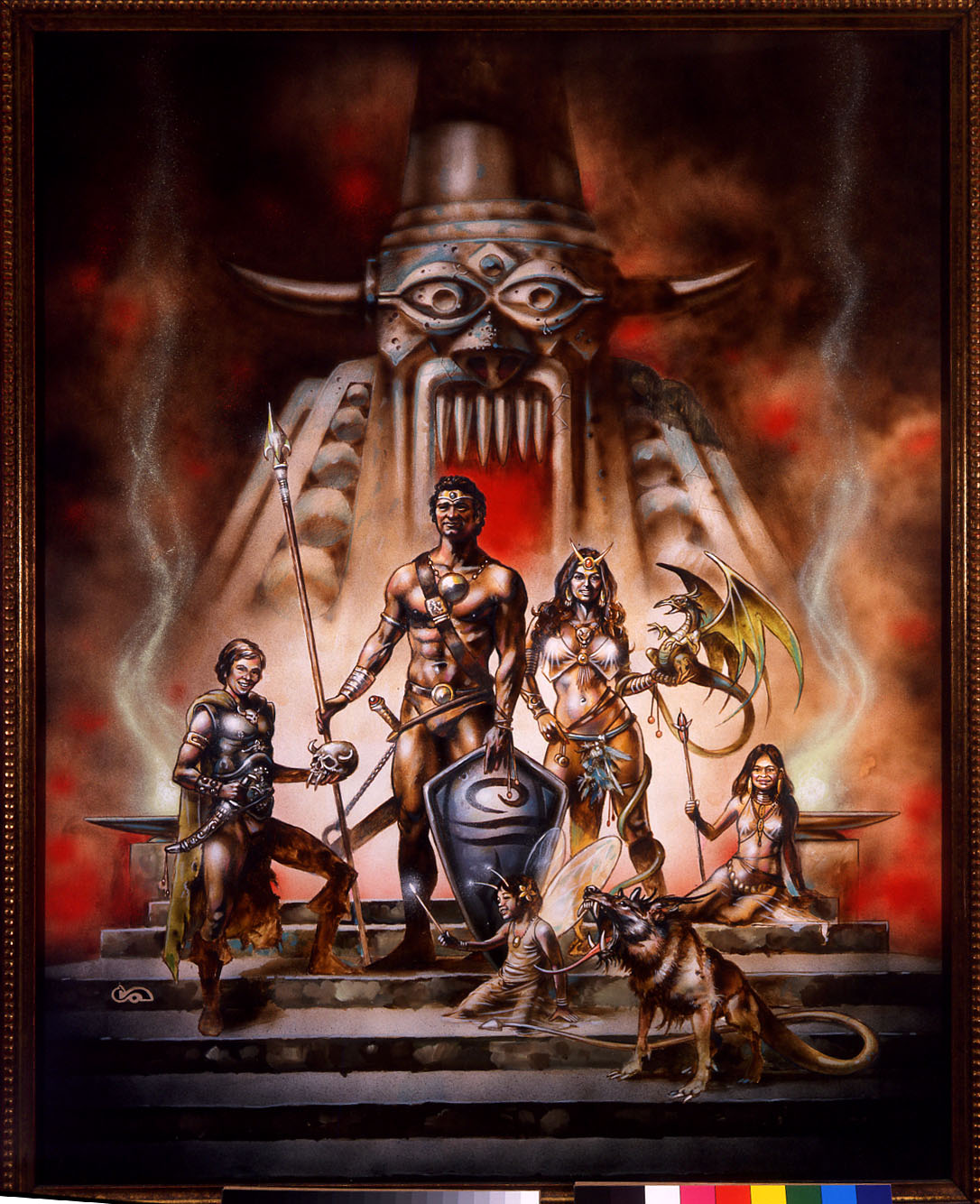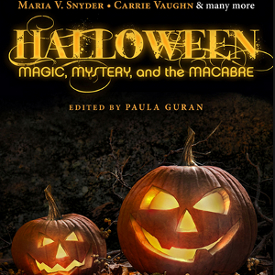
My apologies for leaving this review so late, and so close to the new issue of that magazine. Things are very unsettled around here thanks to the fact that I have to get rid of, by donating, selling, or recycling, close to fifty years’ worth of papers and books and stuff that I’ve been hauling around—from country to country and city to city—most of my life, it seems. “We’re getting very near the end” of that, as Billy Shears’ band said at one point. I also need to tell you that I have to break up my paragraphs more, as I’ve been told by a reader they’re much too dense for phone screens. So onward.
FULL DISCLOSURE – Nina Kiriki Hoffman (Figure 1), whose name is at the very top of the cover for the May/June 2017 F&SF (Magazine of Fantasy and Science Fiction, as if you didn’t know), has been a friend for something close to forty years. Back in the late ‘70s and early ‘80s, when she was attending the University of Idaho, she was a part of the SF fan group I started (PESFA—the “Palouse Empire Science Fiction Association”) in the area.
She was part of the MosCon group that put on MosCon (the Moscow-Pullman SF convention that lasted over 20 years), and she was one of the original people (and a key figure) in the writing group, Writers’ Bloc (that Algis Budrys called “The Moscow Moffia”), I started back then.
(This is not to toot my own horn, because I had a lot of help doing those things; however, I believe I may have been the first person in our group to realize the raw talent of Ms. Hoffman back in the day. I told her more than once that if anyone in our group became a well-known writer, it would be her, thanks to her way of looking at the world and writing about it.) But our friendship, even though I haven’t seen her for many years, is not the reason I tout her writing; she’s just that good!

Contents of the May-June 2017 issue as follows (I won’t be reviewing them in this order):
Brian Trent: “A Thousand Deaths Through Flesh and Stone”
Shannon Connor Winward: “Witch’s Hour”
Mary Soon Lee: “The Path to Peace”
Richard Bowes: “Dirty Old Town”
Paul Di Filippo: “PLUMAGE FROM PEGASUS: Happiness Is a Worn Gunn”
Matthew Hughes: “The Prognosticant”
Kelly Jennings: “The History of the Invasion Told in Five Dogs”
Gregor Hartmann: “What the Hands Know”
Zach Shephard: “Woman”
R. S. Benedict: “My English Name”
John Schoffstall: “The First Day of Someone Else’s Life”
Leah Cypess: “Neko Brushes”
Nina Kiriki Hoffman: “Rings”
Let’s start our review of this issue with a look at Nina’s story, “Rings.” Nina often writes fantasy; her characters frequently have innate powers, and many of the stories are based around interactions within families. She has won many awards—including the Bram Stoker Award for her very first book, The Thread That Binds the Bones—so it’s unusual to see a story that’s strictly science fiction—and good science fiction, too.
The titular rings are used on an Earth-like planet—though the portion we see appears to be largely desert—as both symbols of connection (much as we use wedding/engagement rings) and objects of power. Power, you say? Yes, because this is a planet where women are very much in power, and these rings—apparently powered by an old self-maintaining computer from hundreds of years ago when the original colony ship landed—are used to control others, both men and women.
Slavery is very much legal here, and Aris Lifebuilder, the protagonist, has just purchased a man. (The last names of the women denote their professions, like Searsta Teacher and Beart Miner.) There is also a “mankiller virus” loose on this planet—obviously there to keep the males in check—that all captive males must be inoculated against every few weeks.
The great thing (for me) about Nina’s writing is that without long exposition—information dumps—she is able to describe an entirely different society in quite a bit of detail. Aris’s interactions with her purchased man, Firen, and what we learn about her background leave us wanting to know more after the story is over; and there is a slight possibility that this story will be continued. Although I decry slavery in any form, Nina’s writing is so vivid and Aris’ thoughts, in some ways very rebellious against her own society, make me want to know more. An excellent story.
”Witch’s Hour,” by Shannon Connor Winward is fantasy, not sf. It’s one of those—and I don’t mean anything really negative by this—“generic medieval” fantasies that have been popular for years. There’s a king, and a castle (Castle Lochhunte), and a nearby village; and as is usual, no sign of infrastructure. That’s okay; that’s not really relevant to this story. All we need to know is that Esmelda is the head cook and the protagonist of this tale.
She’s been the head cook for several years, after secretly disposing—using magic and herbs—of her predecessor, Ballard, who was forcing her to have sex against her will. Esmelda is of Wanderer blood; the Wanderers are somewhat similar to the Roma of our world, they are traders with their own ways and their own tongue—and the women can practice magic. Esmelda bound the old king to her by adding certain spices—and incantations in Wanderer tongue—to certain meals she served; the new king, Sutton, is as yet an unknown quantity.
There is a problem, however: the old cook (Ballard) is still around, as a ghost—mostly poltergeist—and he appears to be getting stronger as time goes by. Meanwhile, Sutton has noticed Esmelda’s womanly attributes and is getting interested, even though he’s—through Esmelda’s magical cooking—betrothed to a neighbouring noblewoman. One of the things I liked about this story, even though I generally decry “generic medieval” fiction, is that Esmelda’s magic has a price.
I feel that if magic did exist, it would have laws to obey, similar to our laws of physics; these Harry Potter-like magical stories where all you have to do is wave a wand and incant something kind of get on my nerves. There should be a learning curve and a price, in my opinion. And Esmelda alone won’t pay the prices for a resolution to this story. I liked it.
”Dirty Old Town,” by Richard Bowes (another award-winning writer), is about magic of an entirely different kind. Set in a world that no longer exists—South Boston of the 1950s—it involves what people often think of as typical Irish magic—the gift of gab.The unnamed protagonist grew up in an area that has since deteriorated, but his Celtic background informs all his stories; when he tells a tale he calls a “McGabber,” it has that Irish lilt we often associate with Bostonians.
His background involves a boy he grew up with—a kind of “like-hate” relationship in which his grandparents also figure; a young man named Eddie Mackey, who later became a well-known character actor called Ed Mack. There’s another kind of magic taught to our protagonist by his grandmother, to save him from the depredations of a youthful Eddie Mackey and his brother. These are complicated relationships—and what kinds of relationships, among family and friends, are not? A bitter-sweet tale of love and loss and a kind of redemption. Well done!
R. S. Benedict’s “My English Name” is her first published story, fueled by her years of teaching English in China. I’m not exactly sure how to describe this story without at least a little spoiler, but I suspect it’s not possible. Here goes: the protagonist (and this one’s told in first-person) is not exactly human.
(I’ll use one of those invented pronouns in this review, since “it” is very awkward; how about “xe”?) Xe doesn’t exactly know what xe is, either—but it can make or grow a human skin, and xe’s body changes size and shape, mostly as needed. As the story begins, xe is a maid named Tingting in Hunan province, who is becoming a Westerner (a waiguoren) named Thomas Majors.
But the effort is badly done, and Thomas Majors doesn’t look exactly like xe had wanted him to; in China, that’s not a big deal, apparently, because in China they’re used to fakes. There are knock-offs of everything: clothing, luggage, DVDs, electronics, and so on—so why not fake human beings?
The story chronicles Thomas Majors’ rise and fall in detail—and it is, to my mind, wonderfully written. And the setting is also exquisitely detailed; without being lectured, we learn a fair amount about Chinese customs and how they view Westerners. I foresee great things in store if this author can keep up this level of writing!
Matthew Hughes’s “The Prognosticant” continues the adventures of Baldemar, a wizard’s henchman, who was introduced to readers in the April/May issue of F&SF. Set in the same milieu as Hughes’s “Raffalon” stories (indeed, said character makes a cameo—as a younger edition of himself—in this story). Baldemar’s wizard (Thelerion) has promoted him to a position of responsibility—he is now the underchief responsible for security of Thelerion’s estate.
He must oversee all the little details, such as: what has triggered the “got-you-now” tree that grabs and eats intruders; why are there sometimes footprints leading up to a certain flower bed and none leading out (a common occurrence; things aren’t always what they appear to be chez Thelerion), and what the heck is that thing under the doormat—the thing with all the legs and teeth—called?
Thelerion desires the Helm of Sagacity, an item thought lost in the trackless sands (they’re trackless because all the sand crabs and hundred-legged leeches tend to eat intruders) for eons; and he sends Baldemar and his superior, Oldo, on a flying platform to retrieve it. They are given some implements to aid in this endeavour, and strictly admonished to watch out for a guardian of some sort, though Thelerion can’t say what kind. Of course, things go wrong. This is, after all, the same world in which Raffalon, a thief (sorry, I mean a member of “The Ancient and Honorable Society of Purloiners and Purveyors”) operates; it’s not always his fault that Raffalon’s ambitions often exceed his capabilities.
This particular tale is less Jack Vance-y than some previous ones; I’ve told you that Hughes’s Raffalon tales remind one of Vance’s Cugel, but this one is a bit more sui generis. An entertaining story, as Hughes’ stories tend to be.
“The Path to Peace,” by Mary Soon Lee is a poem about loyalty, and peace, and reminds me of an old saying—something about not putting your trust in prophecy.
Paul Di Filippo’s “PLUMAGE FROM PEGASUS: Happiness Is a Worn Gunn” was apparently sparked by a newspaper article about a bookstore that gives a 10% discount to anyone carrying a visible gun. Di Filippo reviews books for F&SF, so he’s the perfect person to write something that is at once a scathing condemnation of some recent gun laws, a chilling “if this goes on”…and also a Feghoot. (It is actually a bit of a hoot, too!)
For those of you unfamiliar with Feghoots, they originated, as far as I know, in the pages of F&SF; they were shorts that went under the Whovian-sounding rubric of “Through Time and Space with Ferdinand Feghoot.” They were the ultimate SF-ian shaggy dog stories. They were, if memory serves, written by Reginald Bretnor under the pseudonym of “Grendel Briarton” (an anagram, as you can tell, of his own name).
(I remember a particular one from years ago when Feghoot and his male child visited the Hawaiian Islands before the advent of Cook (or whomever “discovered” them) and was astonished to see the Hawaiians dipping up handsful of ground-up enemy as a kind of mush. The younger Feghoot was disgusted, but Ferdinand himself told the boy that cultural morés differed at that time. “After all,” he said, “One man’s meat is another man’s poi, son!”
“A Thousand Deaths of Flesh and Stone,” by Brian Trent, is another pure SF story. This one starts on Luna in the far future. The protagonist is named Alexander Pope Harris, a member of the Order of Stone on Mars (a governmental agency), and he’s searching for a war criminal—a Partisan named Sabrina Potts, who ran the death camps during the war.
In this future, people can save their memories and personalities, and even beam them long distances; Harris has been uploaded to a new body more times than even he remembers. The plot here is rather thin, but the action carries the story along quite well. I always enjoy a little future fiction filled with fighting and blood and future tech.
Well, we’re over 2,000 words, and as you know, I like to leave a little something for the reader; I’ve only described/reviewed roughly half the stories and poems in this issue. I’d give it an overall four what’s-its, like so: ¤¤¤¤. I thought it was well worth reading.
Please comment on this week’s column. I’d like to hear what you think of my reviews, and how I might (in your opinion) improve them. You can comment here or on my Facebook page, or in the several Facebook groups where I link to this column. Your comments are all welcome, good and bad. And don’t feel you have to agree with me to comment; my opinion is, as always, my own, and doesn’t necessarily reflect the views of Amazing Stories or its owners, editors, publishers or other columnists.

LAST WORDS: Today (Thursday) at noon, I just found out that my friend—and a good friend to MosCon and PESFA—John Dalmas has died. I understand he was in the hospital with pneumonia for a couple of days. We last saw our “Onkel Sven” (as we called him) at MisCon, in Missoula, MT a few years ago. John was a fine fellow and a very good writer–he wrote The Yngling, The Caliph’s War, The Regiment and a lot of other good books. You will be missed, John! (This column was already submitted, so this is a last-minute addition.) Also, they’re redoing my home office carpeting next week—all this divesting is to prepare for that—I must have my whole office empty. So if I find it impossible to write this column on my laptop, I may not have a column next week. If I don’t see you, have a great two weeks!











Delighted to see that old friend Nina is still putting out excellent fiction. I display her charcoal drawing of “Little Alex” from Clockwork Orange in my study–purchased at a MosCon fundraiser back in the day. Writing is just one her talents!